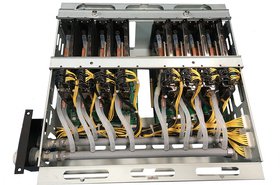Edge computing ecosystems are growing in complexity and requiring better, more comprehensive management solutions.
Increasingly, automated solutions offering total visibility into networked critical infrastructure assets are essential for resilience at the Edge. Many IT leaders need a way to expand network architectures without adding a large number to their workforce.
With all they are managing, it’s common for IT leaders to lose focus on uninterruptible power supplies (UPSs), rack access, power distribution units (PDUs), and cooling equipment.
But protecting these assets from potential failure from extreme temperatures, humidity, or other factors is essential to maximize uptime and ensure smooth business operations.
There are many remote management tools available, but some only monitor physical infrastructure, forcing IT leaders to invest in more than one to piece together the complete solution they need.
Achieving cohesive Edge computing management
Today’s campuses – whether business, healthcare, education, or others – depend on high-tech infrastructure to maintain smooth operations. Often, the consequences for an equipment failure are significant.
However, cohesive infrastructure management is especially challenging in a distributed Edge computing environment where each facility has different needs and conditions for things like energy or cooling.
This can lead to a proliferation of multiple systems with multiple administrative tools, making it impossible to integrate facility-wide performance data to identify opportunities for optimization.
IT teams also need real-time visibility into all of their deployments in order to guarantee performance and maximize uptime. Diagnostic and management tools are needed to ensure the systems that protect assets (power, cooling, etc.) are running at optimal levels.
The ability to spot immediate dips in performance can help them to perform proactive maintenance to avoid unexpected outages. Software should integrate with existing tools to deliver meaningful and actionable data that allows the business to reduce problem response times and simplify maintenance and management.
Another critical piece is ensuring well-trained IT support is available on-site to perform maintenance or repairs. Without that, organizations risk hardware damage, extended downtime, and critical data loss.
For many, it isn’t feasible to add specialized support staff to each site. Finding the right monitoring solution to manage Edge computing can help you get past that obstacle.
End-to-end visibility helps trim costs
Just as centralized data centers require a layer of protection over the cooling and power infrastructure to protect the investment and keep maintenance and remediation costs low, the same is true for Edge deployments.
Moving to a modernized digital solution to add that protective layer to Edge sites is a great way to mitigate unplanned downtime and automate remote maintenance and management. However, not just any solution will work.
The true value is in the flexibility and integration capabilities a solution offers. Plug-and-play, highly scalable options with real-time monitoring wraps around your entire Edge ecosystem to centralize device management into one interface, boosting operational efficiency and maximizing uptime at a lower cost.
Add predictive analytics to the bundle, and IT leaders can convert the overhead of asset management into an advantage using operational data to propel automation.
What to look for in an Edge computing solution
A cloud-based data centre infrastructure management (DCIM) solution can help IT teams simplify Edge infrastructure management to ensure smooth operations.
Look for next-gen solutions that deliver deep and detailed insights across edge environments thanks to their interoperability with third-party and proprietary technologies.
Your DCIM solution should centralize all hybrid IT equipment for proactive monitoring and real-time end-to-end visibility into your physical IT infrastructure.
Customizable dashboards should allow your administrators to manage remote devices like UPSs, PDUs, rack access, and cooling equipment in one place, with notifications alerting IT to potential issues with malfunctioning devices.
Choose a solution that gives you all the information your teams need to be proactive about IT maintenance and parts replacement. Complete offerings will use machine learning and analytics to identify opportunities for optimization as well as potential risks to be mitigated. Analytics also drive benchmarking, so teams can evaluate and compare device performance across locations.
Overall, the solution should simplify and optimize total hybrid device management so your IT team can focus on security and optimization. Solutions with a public API are useful for IT teams integrating remote monitoring into their existing systems.
Edge computing assets are becoming more and more critical to your business operations, making it essential to build safeguards into your infrastructure from the ground up.
Protecting your IT investments and your business from costly downtime and performance interruptions is more important than ever. As the complexity of IT and especially Edge infrastructure explodes, it’s common for IT teams to get overwhelmed.
They can benefit from the 24/7 support that a single trusted advisor for remote management, maintenance, and upgrades can offer – contact Schneider Electric to get started.
You can also check out Schneider’s white paper, “Attributes of effective DCIM systems for distributed, hybrid IT Environments” to learn more.
More from Schneider Electric
-

Sponsored Omnichannel or bust?
Why retailers are turning to the Edge
-

Schneider to sell Chilldyne direct-to-chip liquid cooling systems
Adds another cooling option to its arsenal
-

Sponsored Managed power services: Maximizing uptime and opening up the Edge
Examining the high-growth Edge (and revenue) opportunities made possible by managed power services


